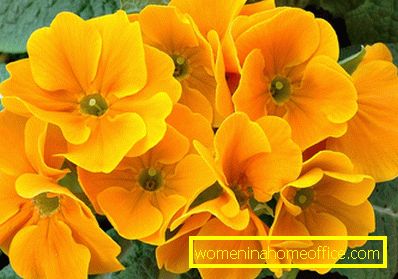Primrose
Quite often, wild plants due to the diligence of scientists turn into indoor. Primula is not an exception. At present, there are both garden species of primrose and houseplants. Primulas belong to the group of ornamental flowering potted indoor plants.
The appearance of primrose
Primroses, or primroses, are among the most beautiful indoor plants. These are small plants with leaves and flowers of medium size, closer to small ones. Well bloom in winter and spring.

The most common type of primrose - Primrose, softish - has white, pink, red and purple flowers. Flowers are usually from 1.8 to 4 cm. They are arranged in tiers on the peduncles. Peduncles thin, strong, usually up to 30-45 cm in length. Peduncles may not be, then the flowers are formed in the middle of the rosette of leaves.
There are also species of primrose with orange, yellow and blue flowers. Distributed species with two-colored inflorescences (for example, purple flowers with a yellow middle). The edges of the petals of flowers may be wavy.
Leaves different forms: ovate, heart-shaped, oblong. Also leaves can be with a mealy patina or rough surface.
Some primrose leaves contain chemicals that, when touched, can cause skin irritation, manifested in the form of red spots. therefore people with sensitive skin should not touch them.
Location in the house
Primula can decorate your homely window sills with its abundant flowering. The best place for her is in the kitchen. You can also place in the bedroom, living room and nursery. Make sure that the place you chose was very light, cool, with an influx of fresh moist air. The cooler on the windowsill, the longer the primrose will bloom. At room primrose, June is considered a period of rest. Well, if his plant will hold on the balcony or in the garden, but always in the shade.
Primrose care
- Lighting.Primula is contraindicated in direct sunlight, but requires a bright diffused light.
- Temperatureaverage, and in the flowering period not higher than 12 ° С -16 ° С.
- Air humidityshould be good. If the plant is not in the kitchen, it is necessary to spray the leaves. If the air is too dry (on the windowsill), the plant pot is placed on a tray with pebbles.
- Wateringmoderate, 2-3 times a week, and during flowering plentiful. Watering primrose preferably through the pan. Water for irrigation is desirable to definitely defend. Water with warm water.
- Breeds primrose seeds somewhere in the middle of summer.
Primrose pests and diseases
- When overwetting the soil, especially with cold water, the primrose can be damaged by gray mold. If this suddenly happened - do not panic, you can cure it as follows: temporarily stop watering, apply crushed ground charcoal or ash to sore spots. You can also treat them with a solution of the drug "Chom" (1 tsp per half liter of water).
- When too dry, the plant may be affected by spider mites or aphids. To get rid of aphids can be advised to use the infusion of tobacco or garlic. They need to spray the leaves of sick plants. When a spider mite appears, the plant is treated with Karbofos (6 g per 1 l of water) or Spark (1/10 tablet per 1 l of water).
- Primula needs good lighting, protection from drafts and direct sunlight, moderate temperature and good humidity. Faded flowers are carefully removed.
After flowering primula can be planted in open ground (stemless primrose). Primrose chinese and primrose back conical leave for next season. To do this, the plant is transplanted after flowering and put in a cool shaded place. It should be well ventilated.
To force the primrose to bloom again, in 3-4 months increase watering.
Do not forget that there are species of primroses that are thrown away after flowering (read the article "Species of indoor plants"). Therefore, be sure to consider this when choosing a flower.
